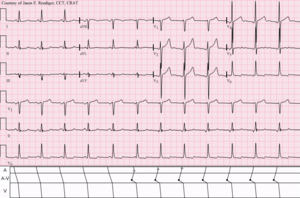Wandering atrial pacemaker
| Wandering pacemaker | |
|---|---|
 | |
| Shifting (wandering) pacemaker | |
| Specialty | Cardiology |
Wandering atrial pacemaker (WAP) is an atrial arrhythmia that occurs when the natural cardiac pacemaker site shifts between the sinoatrial node (SA node), the atria, and/or the atrioventricular node (AV node). This shifting of the pacemaker from the SA node to adjacent tissues is identifiable on ECG Lead II by morphological changes in the P-wave; sinus beats have smooth upright P waves, while atrial beats have flattened, notched, or diphasic P-waves. It is often seen in the very young, very old, and in athletes, and rarely causes symptoms or requires treatment.[1]
Although causes of wandering pacemaker aren't clear, age factor is said to be contributing though. Aged individuals and children are vulnerable. Athletes with good physical condition may suffer from this. Sometimes Digoxin toxicity could trigger this phenomena.[citation needed]
References[]
- ^ Huff, J. (2016). ECG workout: Exercises in arrhythmia interpretation (7th ed.). Philadelphia, PA: Wolters Kluwer.
External links[]
| Classification |
|---|
- Cardiac arrhythmia